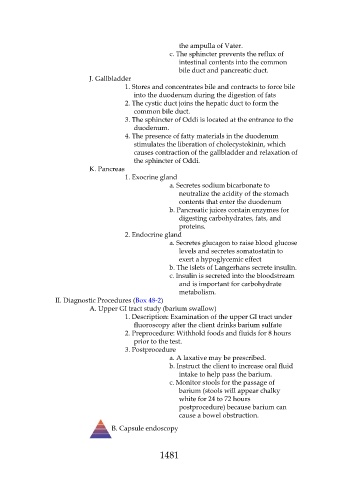Page 1481 - Saunders Comprehensive Review For NCLEX-RN
P. 1481
the ampulla of Vater.
c. The sphincter prevents the reflux of
intestinal contents into the common
bile duct and pancreatic duct.
J. Gallbladder
1. Stores and concentrates bile and contracts to force bile
into the duodenum during the digestion of fats
2. The cystic duct joins the hepatic duct to form the
common bile duct.
3. The sphincter of Oddi is located at the entrance to the
duodenum.
4. The presence of fatty materials in the duodenum
stimulates the liberation of cholecystokinin, which
causes contraction of the gallbladder and relaxation of
the sphincter of Oddi.
K. Pancreas
1. Exocrine gland
a. Secretes sodium bicarbonate to
neutralize the acidity of the stomach
contents that enter the duodenum
b. Pancreatic juices contain enzymes for
digesting carbohydrates, fats, and
proteins.
2. Endocrine gland
a. Secretes glucagon to raise blood glucose
levels and secretes somatostatin to
exert a hypoglycemic effect
b. The islets of Langerhans secrete insulin.
c. Insulin is secreted into the bloodstream
and is important for carbohydrate
metabolism.
II. Diagnostic Procedures (Box 48-2)
A. Upper GI tract study (barium swallow)
1. Description: Examination of the upper GI tract under
fluoroscopy after the client drinks barium sulfate
2. Preprocedure: Withhold foods and fluids for 8 hours
prior to the test.
3. Postprocedure
a. A laxative may be prescribed.
b. Instruct the client to increase oral fluid
intake to help pass the barium.
c. Monitor stools for the passage of
barium (stools will appear chalky
white for 24 to 72 hours
postprocedure) because barium can
cause a bowel obstruction.
B. Capsule endoscopy
1481

